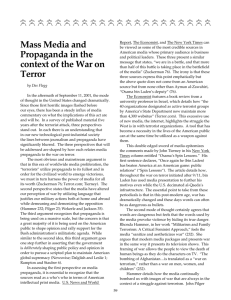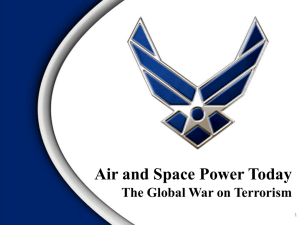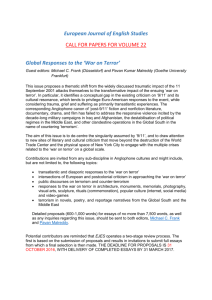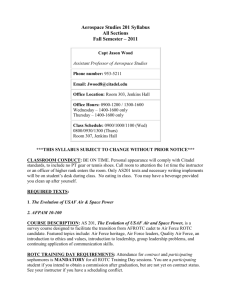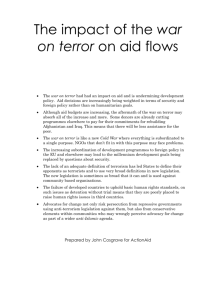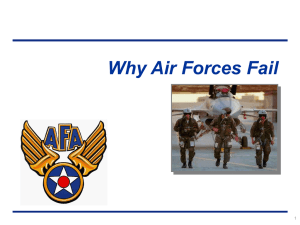The Global War on Terror Background
advertisement
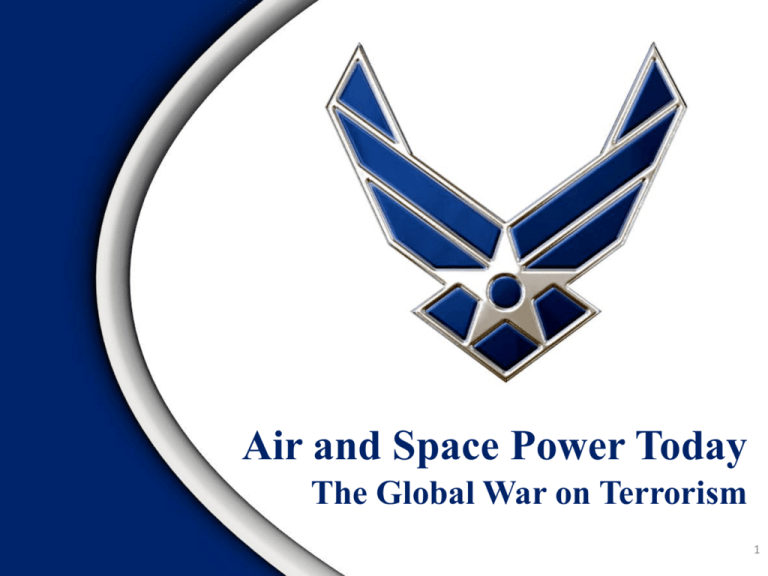
Air and Space Power Today The Global War on Terrorism 1 Overview •The Global War on Terror – Background – Launching a War on Terrorism •Operation ENDURING FREEDOM (OEF) – Airpower’s Distinctive Contributions – Problems with Airpower Execution – Operation Anaconda •Operation IRAQI FREEDOM – Background – The Military Campaign – Termination of OIF and the Beginning of New Dawn •US National Lessons Learned •Evolution of Airpower 2 The Global War on Terror Background OEF marked the beginning of a broader US and international global war on terrorism, but our enemies actually declared war on us through acts and words years earlier. Sheik Rahman Osama bin Laden 3 The Global War on Terror Background • The 1983 suicide bomb attack against US Marines in Lebanon was our first introduction to this war—220 Marines were killed in the attack. • The first World Trade Center bombing in Feb 1993 killed 6 and injured over 1,000 people. 4 The Global War on Terror Background In 1996, Osama bin Laden issued his fatwa: a “Declaration of War Against the Americans Occupying the Land of the Two Holy Places.” 5 The Global War on Terror Background In 1996, the Khobar Towers USAF facility in Saudi Arabia was attacked with a truck bomb. That attack killed 19 Airmen. 6 The Global War on Terror Background • US Embassy bombings in Nairobi, Kenya, and Dar el Salaam, Tanzania in 1998 • US retaliated with strikes against Sudan and Afghanistan • USS Cole attacked in Yemen, killing 17 Americans US Embassy Nairobi Damaged USS Cole 7 The Global War on Terror Background • September 11, 2001 attack launched on the United States using airliners as piloted missiles – Two airliners crashed into the World Trade Center twin towers (3,000 dead, towers destroyed). – Third airliner crashed into the Pentagon – Fourth airliner crashed into a field in western PA 8 The Global War on Terror Background • Attacks on September 11, 2001 motivated the United States to initiate the Global War on Terrorism • The first battle zone: Afghanistan and the Taliban 9 Launching The War on Terror • United States announces two-pronged approach 1. Go after the terrorists “Our war on terror begins with al Qaeda, but it does not end there. It will not end until every terrorist group of global reach has been found, stopped, and defeated.” 2. Go after their supporters “Every nation, in every region, now has a decision to make. From this day forward, any nation that continues to harbor or support terrorism will be regarded by the United States as a hostile regime.” 10 Launching The War on Terror • Department of Homeland Security is established • American diplomats forge different coalitions of nations willing to engage in the war on terrorism in a variety of ways • Law enforcement agencies, at home and abroad, work around the clock to uproot terror networks and disrupt potential attacks 11 Launching The War on Terror • Financial regulators and law enforcement combine forces to deprive terrorists of sources of financial support • Reserves and the National Guard patrol US skies and bolster the security of airports and other public places • US intelligence community redoubles efforts to gain needed intelligence and prepare for a series of covert actions 12 Launching The War on Terror • Global Perspective • Broader than just Afghanistan – The Philippines – Bosnia – Africa • Introduction of Doctrine of Preemption 13 OEF Military Operations • US Objectives for OEF – Make clear to the Taliban leaders and their supporters that harboring terrorists is unacceptable and carried a price – Acquire intelligence to facilitate future operations against al Qaeda and the Taliban regime that harbored the terrorists – Develop relationships with groups in Afghanistan that oppose the Taliban regime and the foreign terrorists that they support 14 OEF Military Operations • US Objectives for OEF (cont’d) – Make it increasingly difficult for terrorists to use Afghanistan freely as a base of operation – Alter the military balance over time by denying the Taliban the offensive systems that hamper the progress of the various opposition forces – Provide humanitarian relief to Afghans suffering truly oppressive living conditions under the Taliban regime 15 Airpower’s Distinctive Contributions • Data Fusion – Historic deployment of ISR umbrella • E-3s, E-8s, RC-135s, RPAs, U-2s • Fighters w/ infrared targeting capabilities – Targeting coordinates e-mailed to aircraft – Greater connectivity between sensors and shooters – Highly beneficial in joint ops Airpower’s Distinctive Contributions • Air-Ground Synergy – Close synchronization of air and land power • Special forces teams included CIA operatives and Air Force TACP members • Air Force controllers integrated with Army Special Forces – Result was ground-enabled precision strike instead of classic close air support Airpower’s Distinctive Contributions • Humanitarian Relief and Force Sustainment – Air mobility effort was massive—3rd behind Berlin airlift and Desert Shield – Humanitarian aid operation was personal creation of President Bush • 2 million human daily rations had been delivered by 30 Nov – OEF was first American campaign in which airlift provided ALL military supplies for several months Airpower’s Distinctive Contributions • Space Support to Force Employers – Provided info for special ops mission planning – BRITE—Provided near-real-time satellite info – Bandwidth was an issue—Severely limited the number of RPAs that could be in use at a given time – Space support now measured with a stopwatch instead of a calendar Airpower’s Distinctive Contributions • CAOC Operations – New CAOC was at PSAB, Saudi Arabia – Coherent and cooperative group of planners from all the services – Had to handle both OSW and OEF mission – Outstanding system but limited by lack of personnel and training Airpower’s Distinctive Contributions • Buildup at Manas – US military tent cities established at 13 sites in 9 countries – 86th Contingency Response Group was significant player in establishment of Manas, Kyrgyzstan – By May 2002, Manas had about 2,000 coalition forces in place Airpower’s Distinctive Contributions • New Technology – OEF helped validate new concepts and technology • CIA firing of Hellfire missiles from Predators • Earth penetrator weapons; computer-controlled hard-target smart fuse; thermobaric devices – Measurement and signature intelligence (MASINT) • Foliage-penetrating radar • Hyperspectral imaging • Pattern-change tracking technology Problems with Airpower Execution • CAOC-CENTCOM Tension – The “other dynamic” – Caused by CENTCOM’s decision to plan and conduct OEF the same as OSW—strict rules of engagement and targeting procedures – Made worse by divide between CENTCOM Army culture and CAOC Air Force culture – Led to target list issues Problems with Airpower Execution • Rules-of-Engagement Constraints – Severity of 9/11 prompted many to think “gloves would come off” – Political realities necessitated controls seeking to lessen civilian casualties – Time difference hampered getting timely firing approvals – The result: OEF set a new record for strict rules of engagement and targetapproval criteria Problems with Airpower Execution • Trend Toward Centralized Execution – Techno advancement created more efficient & timely operations, but also have enabled direct senior leadership involvement in finest details of force employment. – Technology shortened kill chain, but centralized control often nullified this benefit – If this issue isn’t addressed it will undermine and ultimately destroy one of the nation’s most preeminent military advantages Video Operation Anaconda: The Battle of Roberts Ridge 26 OIF Background • After major combat operations in Afghanistan ended, the US shifted focus to Saddam Hussein’s regime • UN Resolution 687 codified Cease Fire Agreement for the Gulf War • Iraq was testing and breaking these agreements 27 OIF Background • Paragraph 8 stated that Iraq must “…unconditionally accept the destruction, removal, or rendering harmless, under international supervision of:” – All chemical/biological weapons – All ballistic missiles with range greater than 150 km 28 OIF Background • Paragraph 12 addressed nuclear capabilities, stating that Iraq must “…agree not to acquire or develop nuclear weapons or nuclear weaponusable material • Paragraph 32, with regards to terrorism, stated that “…[Iraq] will not commit or support any act of international terrorism” 29 OIF Background • 12 Sept 2002: President Bush addressed the UN General Assembly to highlight observed violations and attempt to gather further international support for action against Iraq • 16 Oct 2002: President Bush signed the Iraq War Resolution • 8 Nov 2002: The UN Security Council passed Resolution 1441 30 OIF Background • Dr. Blix (chief UN investigator) reported non-cooperation to the UN Security Council multiple times • In February 2003, Secretary Powell addressed the UN Security Council 31 OIF Background • 16 Mar 2003: President Bush demanded senior leaders leave Iraq within 48 hours • 19 Mar 2003: President Bush addressed the nation stating that military operations had begun in Iraq 32 OIF Air Campaign • OIF Air Campaign = Operations NORTHERN WATCH and SOUTHERN WATCH • Not a single Iraqi Combat Sortie during OIF 33 OIF Military Objectives • End the regime of Saddam Hussein • Identify, isolate, and eliminate Iraq’s weapons of mass destruction • Search for, to capture, and to drive out terrorists from that country. • Collect such intelligence as the United States and its allies can that is related to terrorists networks. OIF Military Objectives (cont’d) • Collect such intelligence as we can related to the global network of illicit weapons of mass destruction. • End sanctions and to immediately deliver humanitarian support to the displaced and…needy Iraqi citizens. • Help the Iraqi people create conditions for a transition to a representative self-government. Beginning of OIF • Preparatory steps began in late 2002 when nofly patrols began to suppress Iraqi air defenses • 19 March, G-day: Intel reports indicated the location of Saddam Hussein and his sons – Attacked using cruise missiles & stealth aircraft – All forces not in place when operation began • US and British ground forces invaded with little air bombardment preparation Size & Nature of Air Component • United States had more than 1,000 acft in theater as war began; 1,663 fixed-wing acft used at peak of fighting • Combination of sortie generation numbers & sortie quality allowed coalition to generate 41,404 sorties against an Iraqi Air Force that generated NONE Size & Nature of Air Component: Sortie Totals AIRCRAFT TYPE Fighters USAF USMC USN USA BRITISH AUSTRALIAN 8,828 3,794 5,568 - - 302 Bombers 505 - - - - - C2 432 75 442 - 112 - ISR 452 305 357 269 273 - Spec Ops/Rescue Tankers 191 6,193 454 2,058 - 359 - Airlift 7,413 - - - - 263 Other 182 320 520 - 1 - Total 24,196 4,948 8,945 269 2,841 565 Size & Nature of Air Component • Key missions for the coalition air forces – Neutralize the ability of the Iraqi government to command its forces – Establish control of the airspace over Iraq – Provide air support for special ops forces & Army and Marine forces that would advance toward Baghdad – Neutralize Iraq’s forces of surface-to-surface missiles and suspected caches of biological weapons Role of the Reserve Component • Guard and Reserve forces played extensive role in OIF – Made up 9.5% of US troops – Total number of reserves called up by late April 2003: Nearly 224,000 – Air National Guard deployed 236 aircraft and AF Reserve sent 70 Value of Expeditionary Airpower • Expeditionary Combat Support (ECS) critical – 46K sorties w/ 98% maintenance effectiveness rate – Issued more than 1 million gallons of jet fuel – Delivered 21.5 million pounds of ammunition – Served 111,000 hot meals/day; positioned 2.7 million MREs – Positioned 91K chemical warfare suits Intelligence Strength • US space and intel assets to study and target Iraq for more than 12 yrs • ISR assets and data – 80 acft dedicated to ISR mission – Collected 3,200 hrs of streaming video, 2,400 hrs of signal intel, and 42,000 battlefield images Intelligence Weaknesses • All the prewar and war efforts still left major gaps – Lack of experts and analysts – Difficulty in determining activities within buildings – Mistargeting and overtargeting of facilities – Poor casualty and BDA assessment processes Intelligence Weaknesses • Controversial intel problems related to WMD – US and British gov’ts had poor understanding of Iraqi WMD threat – Analysis problems linked to collection problems – Tendency to focus on worst-case scenario – Intel focused more on arms control than war fighting – Intel community avoids explicit statements—leads users to force intel process to a definite conclusion or make personal estimates Urban Close Air Support • Key player in defeating insurgency – Use of preposition air assets in “kill boxes” • Attack helicopters and A-10s played key role – Lower-yield weapons minimized collateral damage Evolving Role of the Bomber • Value of bombers as precision strike capability – Ability to hit up to 70 separate targets in 1 mission – Upgraded elec. warfare capability improved survivability – B-52s and B-1s delivered 2/3 of bombs dropped – AEFs limited by quantity of operational B-1s Role of E-8C JSTARS • Symbol of rapidly evolving role of jointness • Air dominance allowed E-8s to track Iraqi ground forces over hundreds of sq. miles – Iraqis couldn’t hide in sand storms • Highly valued asset – 1st Marine Division: “No other collection asset provided the wide area all weather coverage…that the JSTARS did!” Effects-Based Bombing • Involves selective use of precision airpower to strike targets to produce effects rather than simply maximize physical damage – More efficient and effective use of resources – Use less weapons and strike less targets – Ease concerns for collateral damage and civilian casualties • Made possible by improvements in precision weapons • Even near misses have psychological impact Effects-Based Bombing • Limits to effect-based bombing – Accuracy based on assumption of perfect targeting, launch, and weapon function—rarely happens – Battle damage assessment limitations – Air Force & Army differences over strike planning – Iraqis efforts to counter our efforts • Carried out efforts where satellite coverage was limited • Predicted limits of US sources and methods based on intel received from United States during Iran-Iraq War Termination of OEF and Beginning of New Dawn • Historic milestone on 1 Sep 2010 – End of formal US military combat ops and beginning of stability ops – Emphasis shifted from predominantly military to predominantly civilian • Made possible by increased Iraqi Security Forces (ISF) capabilities • Primary mission of US forces – Advising, assisting, and training ISF – Conducting partnered counterterrorism ops – Provide support to provincial reconstruction teams and civilian partners US National Lessons Learned from GWOT • Wars in the twenty-first century will increasingly require use of all elements of national power • Ability of forces to communicate and operate seamlessly on the battlefield will be critical to success in future wars • Wars best fought by coalitions of the willing, but should not be fought by committee. • Defending the United States requires prevention and sometimes preemption 51 US National Lessons Learned from GWOT • The United States must rule out nothing in advance • Victory in the GWOT requires steady pressure on the enemy, leaving them no time to rest and nowhere to hide • The new and the high-tech have not totally replaced the old and conventional 52 US National Lessons Learned from GWOT • The US must link military operations directly with humanitarian assistance, radio broadcasts, rewards, and other efforts • American leaders must be honest with the American people 53 US National Lessons Learned from GWOT The United States must not make the mistake of believing that terrorism is the only threat of the twenty-first century. Terrorism is a deadly asymmetric threat but not the only possible one. Chinese Forces on parade Iranian Uranium Conversion Facility 54 Now and Beyond video 55 Evolution of Airpower • So, what have we learned? – What were significant airpower achievements and changes during this period? – What was the impact of these achievements and changes? Summary •The Global War on Terror – Background – Launching a War on Terrorism Expeditionary Medal •Operation ENDURING FREEDOM (OEF) – Airpower’s Distinctive Contributions – Problems with Airpower Execution – Operation Anaconda •Operation IRAQI FREEDOM – Background – The Military Campaign – Termination of OIF and the Beginning of New Dawn Service Medal •US National Lessons Learned •Evolution of Airpower 57 Final Thoughts • Final thoughts for you as future Air Force leaders – Even with the recent death of Osama bin Laden, the GWOT is still very much a current event and a conflict we must win • How long will it take? • How vigilant do we need to be? • Are you ready? 58
